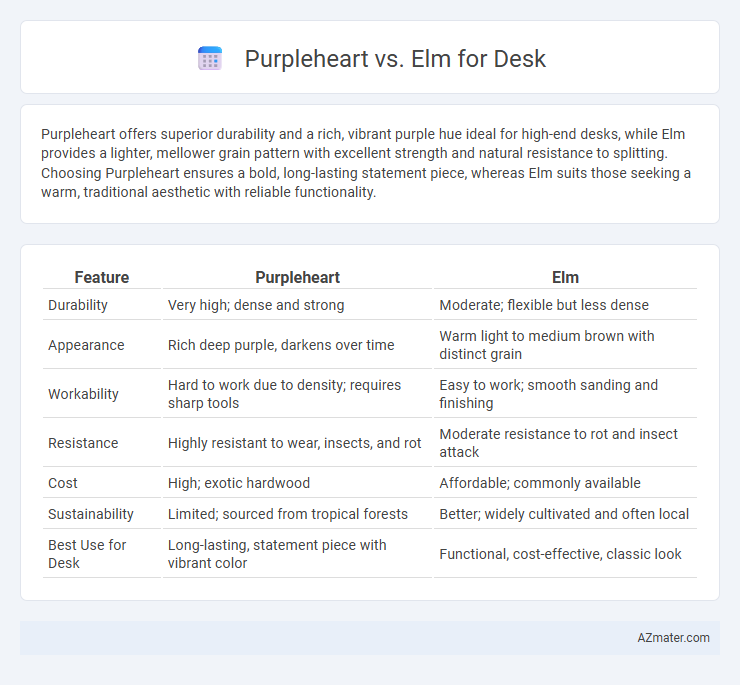Purpleheart offers superior durability and a rich, vibrant purple hue ideal for high-end desks, while Elm provides a lighter, mellower grain pattern with excellent strength and natural resistance to splitting. Choosing Purpleheart ensures a bold, long-lasting statement piece, whereas Elm suits those seeking a warm, traditional aesthetic with reliable functionality.
Table of Comparison
| Feature | Purpleheart | Elm |
|---|---|---|
| Durability | Very high; dense and strong | Moderate; flexible but less dense |
| Appearance | Rich deep purple, darkens over time | Warm light to medium brown with distinct grain |
| Workability | Hard to work due to density; requires sharp tools | Easy to work; smooth sanding and finishing |
| Resistance | Highly resistant to wear, insects, and rot | Moderate resistance to rot and insect attack |
| Cost | High; exotic hardwood | Affordable; commonly available |
| Sustainability | Limited; sourced from tropical forests | Better; widely cultivated and often local |
| Best Use for Desk | Long-lasting, statement piece with vibrant color | Functional, cost-effective, classic look |
Introduction to Purpleheart and Elm Wood
Purpleheart wood, known for its rich purple hue and exceptional durability, offers a striking aesthetic and resistance to wear, making it ideal for high-use desks. Elm wood features a distinctive interlocking grain pattern and excellent shock resistance, providing both beauty and stability in furniture construction. These hardwoods differ significantly in appearance and performance, influencing desk design choices based on desired durability and visual impact.
Origin and Botanical Characteristics
Purpleheart wood, derived from the Peltogyne genus native to Central and South American rainforests, is known for its striking deep purple hue and dense, durable nature. Elm, belonging to the Ulmus genus primarily found in temperate regions of the Northern Hemisphere, features a distinctive interlocking grain pattern that enhances its resistance to splitting. Both woods offer unique botanical characteristics: Purpleheart exhibits high natural oil content and hardness, while Elm is prized for its flexible yet tough fibers and attractive grain texture.
Color and Aesthetic Appeal
Purpleheart wood features a rich, vibrant purple hue that deepens with age, offering a striking and unique aesthetic for a desk. Elm wood displays warm, honey-brown tones with prominent grain patterns that provide a more traditional and rustic look. Choosing between Purpleheart and Elm hinges on whether a bold, eye-catching appearance or a classic, natural appeal is preferred.
Grain Pattern and Texture
Purpleheart exhibits a uniform, straight grain pattern with occasional interlocking, offering a smooth texture that enhances polished surfaces on desks. Elm features a more pronounced, interlocking grain with swirling patterns, creating a visually dynamic texture and added character. The fine texture of Purpleheart contrasts with Elm's coarser feel, influencing choices based on desired aesthetic and tactile experience in desk construction.
Hardness and Durability Comparison
Purpleheart is significantly harder than Elm, with a Janka hardness rating of around 2,520 lbf compared to Elm's 1,150 lbf, making Purpleheart more resistant to dents and scratches. The durability of Purpleheart is superior due to its natural oils and dense grain, which provide excellent resistance to wear, moisture, and decay, ideal for heavy-use desks. Elm, while softer and more elastic, offers good shock resistance but may show wear more quickly under frequent use.
Workability and Machinability
Purpleheart offers moderate workability with a dense, oily texture that can dull tools quickly, requiring frequent sharpening during machining. Elm provides excellent workability and machinability due to its interlocked grain and softer fibers, allowing smoother cuts and reduced tool wear. Both hardwoods produce durable desks, but Elm is preferred for easier shaping and finishing in woodworking projects.
Resistance to Decay and Pests
Purpleheart wood exhibits exceptional resistance to decay and pests due to its natural oils and dense grain, making it ideal for durable, long-lasting desks. Elm also offers moderate resistance to decay and pests but is less durable compared to Purpleheart, requiring additional treatment in high-moisture or pest-prone environments. For desks exposed to varying conditions, Purpleheart provides superior longevity and maintenance ease.
Maintenance and Care Requirements
Purpleheart wood requires minimal maintenance due to its natural resistance to decay and insects, making it ideal for desks exposed to varying humidity. Elm demands more care to prevent warping and cracking, benefiting from regular oiling to maintain its moisture balance. Both woods perform well with gentle cleaning, but Purpleheart offers greater durability with less frequent treatment.
Environmental Impact and Sustainability
Purpleheart wood is prized for its durability and vibrant color, harvested from trees native to Central and South America, but concerns about deforestation and habitat disruption often arise due to less regulated logging practices. Elm offers a more sustainable choice, commonly sourced from North American regions where controlled harvesting and reforestation efforts ensure a lower environmental footprint. The ecological advantage of elm desks is enhanced by their biodegradability and the tree's natural resistance to pests, minimizing the need for chemical treatments often used in purpleheart maintenance.
Conclusion: Which Wood is Better for Your Desk?
Purpleheart offers exceptional durability and a striking deep purple hue that darkens over time, making it ideal for a statement desk with long-lasting wear resistance. Elm provides a lighter, warm tone with a distinctive grain pattern and excellent shock resistance, suitable for those favoring a natural, rustic appearance and functional comfort. Choosing between Purpleheart and Elm depends on your preference for bold aesthetics and durability versus warmth, natural grain, and moderate resilience in a desk surface.

Infographic: Purpleheart vs Elm for Desk
 azmater.com
azmater.com